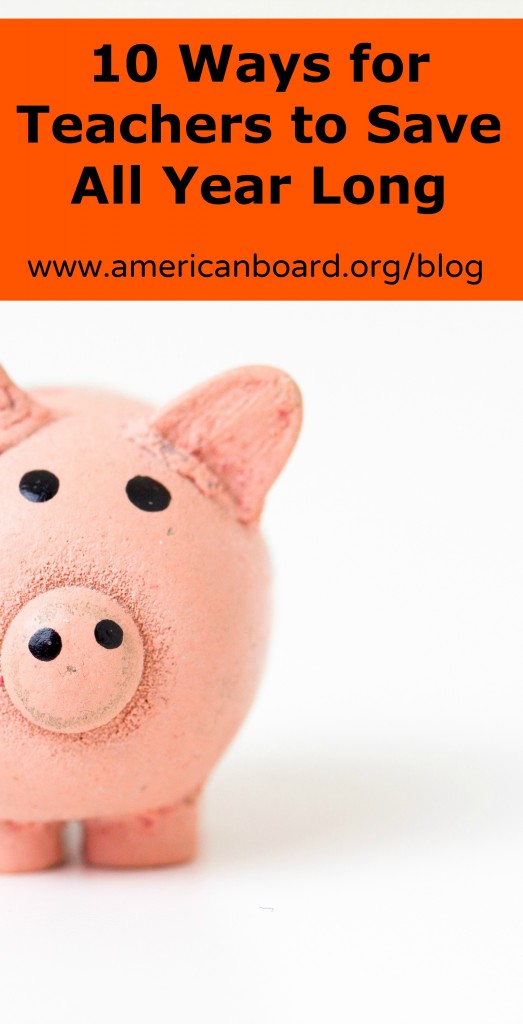10 Ways for Teachers to Save Money

Teachers are passionate people; passionate people who spend more on their students and classrooms each year thanks to dwindling district-wide budgets. In fact, on average, teachers nationwide spend between $500-$1,000 of their own money on their classrooms annually.
Between supplies, themed-decorations, and keeping up with the latest technology, it can seem almost impossible to make ends meet yet have an effective, up-to-date classroom. Thankfully, there are some ways that teachers can make their dollars go just a little bit further. Check out these 10 ways for teachers to save money.
1. Shop at the Right Time
July and August are the best times for teachers to save money as they shop for their classrooms thanks to back to school deals and tax holidays. Check your favorite supply store’s calendar before shopping to find their tax-free weekend(s). If you prefer to shop on Amazon, take advantage of Prime, which gives you free 2-day shipping, and Amazon Prime Day in July. Don’t miss Amazon’s Black Friday and end of the year clearance deals as well.
2. Use Your Educator’s Discount
Many stores offer a discount of up to 20 percent for teachers—an added perk outside the classroom—including Big Lots, J. Crew, Adobe, JoAnn Fabric, and Blick Art Materials. Those aren’t the only places where you can save by being a teacher. You can also get free admission to aquariums and amusement parks, and discounts on a variety of magazines, DVDs, and book subscriptions. Check out a long list of these discounts and freebies here.
3. Buy in Bulk
School supplies, just like groceries, are often much cheaper when bought in bulk. Buying in bulk also means that you’ll only have to visit the store or order online once or twice a year, rather than once a month. Talk to other teachers on your grade-level and see if they need the same things if you don’t meet minimum ordering requirements. Websites such as Discount School Supply offer these items at a great price for teachers.
4. Use Your Community
Other teachers and friends may be able to buy items that you don’t have access to. Tell your friends or coworkers about the items you’re looking for and see if they have any secret deal spots. For example, some of your coworkers may receive coupons from stores that you don’t or have loyalty points they aren’t using. Organize the group with a Facebook page, where everyone can share the deals and items they have access to.
5. Recycle
Adopt a policy of recycling and reusing in your classroom at the beginning of the year. Invest in labels to make used items such as folders and notebooks look new for this year’s students. Pick borders and decorations that are durable and you know can be used for several years. Laminate charts, borders, cutout letters, or anything that could be reused.
6. Don’t be Afraid to Ask Around
Always, always, always ask your teacher friends if they have supplies before buying your own. A veteran teacher may be trying to get rid of books that you could use or someone down the hall may be throwing out used furniture. If you want to get rid of something, don’t throw it away until you’ve emailed your colleagues to ask if they want it too.
7. Ask About Grants
Maybe you have a really cool project but you can’t possibly fund it yourself or you’re running low on classroom basics. Applying for a grant is one of the best ways to get funding for your classroom. Every grant is different so this may require some research, but the benefits of doing your homework can be astounding.
Check out websites like Kids in Need Foundation and DonorsChoose.org, where people can choose to donate money to your cause.
8. Seek Help from Your Student’s Parents
Your wish list covers the items you need at the beginning of the year, but it’s not ongoing. Use your weekly newsletter to ask parents for specific items such as Kleenex, paper, hand sanitizer, etc. This way, parents can choose to help as they can, rather than feeling required to do so.
9. Educator Tax Deductions
When tax season rolls around, don’t forget to claim your educator tax deduction. There’s a $250-dollar above the line (which means it doesn’t have to be itemized) deduction for classroom supplies for teachers. While it may not be a significant amount, you don’t want to leave it unclaimed. If you’ve been continuing your education—whether mandatory or not—there are some deductions for professional development as well. Be sure to research all of your options and consult your CPA.
10. Teachers Pay Teachers
In addition to being a full-time educator, some teachers are now turning to Teachers Pay Teachers to make extra money for their creative ideas. Also known as an “Etsy for educators,” the site features ready-to-use lesson plans, classroom decorations and worksheets, workbooks, and much more. No one knows what you need like another teacher, so if you feel you have something to offer or need ideas, sign up for an account on Teachers Pay Teachers.
Know any other ways for teachers to save money? Leave your ideas in the comments below!






